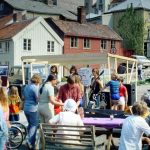What do you do as a Wikimedian in residence?
Traditionally a Wikimedian in Residence focuses on increasing the quality and quantity of content on Wikipedia and its sister projects, such as Wikimedia Commons (for openly licenced media) and Wikidata (for linked open data). When I first started as a Wikimedian in Residence at the National Library of Wales the goal was pretty simple. Firstly I would run events and workshops aimed at improving the quality of content about Wales and its people on Wikipedia, in English and Welsh. Secondly, I was tasked with sharing the library’s digital assets on an open licence via Wikimedia Commons so that they could be used to illustrate Wikipedia articles.
As the project evolved we began to collaborate with the Welsh Government on thematic projects aimed at increasing the availability of information in Welsh on Wikipedia, as part of their long term strategy for the language. We have worked to improve content about health and medicine, pop music, Welsh people and literature, and we are currently working with the education department to identify and develop Welsh language content needed by school children to support their studies.
We have also increasingly engaged in sharing our catalogue data via Wikidata as linked open data.
How did you get interested in this job?
Before I took on my role as a Wikimedian I worked as a research assistant in the maps and manuscripts department. My first experience of editing Wikipedia came after an article I had published was used as the bases for a Wikipedia article. I was really impressed by the speed, efficiency and accuracy of Wikipedia editors in taking reliable peer reviewed information and making it available to all on Wikipedia. And I was amazed at the ease with which I was able to edit and make improvements to the article. It was shortly after this that the Library, in partnership with Wikimedia UK, advertised for the post of Wikimedian in Residence.
What are the biggest challenges in your work?
I’ve been incredibly lucky to have great support from the National Library. However, any disruption to long established norms will obviously present challenges. The public engagement side of my work doesn’t really present any major problems but sharing data openly definitely requires care.
Wikimedia projects all follow an ‘open’ ethos. All the content created on Wikipedia, or media, and data shared on these platforms must be openly licenced in order to remove barriers to reuse. ‘Open’ in this instance means more than simply making something available for free, it means removing restrictions on reuse. Content must be downloadable and licenced for free use for any purpose including commercial reuse. It’s a fantastic approach, which is being adopted by more and more cultural institutions in order to give their users the best possible value, to simplify work streams and to encourage maximum engagement with their content.
But we need to be careful about what we share. If an item contains 3rd party copyright of any kind we don’t actually have the right to share it openly. To minimise risk, we have focused on sharing public domain content (digital versions of items which we know are out of copyright).
Another challenge, as a publicly funded institution of finding the balance between giving our users the best access and meeting targets for income generation. We try to identify where there is commercial potential in collections and share those in a different way, or often we share screen resolution images openly and retain the highest quality digital images for commercial licencing. The current trend though seems to be to simplify these processes by simply giving unlimited access to all digital versions of public domain works
Why did the National Library decide to open this position?
About a year before the library appointed a Wikimedian in Residence they made a policy decision not to claim any rights to digital reproductions of out of copyright works. This was the first step towards ‘Open Access’, but they recognised that a policy decision alone would have resulted in very little impact or change. So one of the main aims with the Wikimedia residency was to use Wikimedia Commons to actively share our public domain content on an open licence in order to encourage reuse and engagement.
The position was also fully supported by our local Wikimedia chapter – Wikimedia UK. They initially helped to fund the position and provided training and logistical support. This support obviously reduced the risks for the National Library and made the idea of hosting a Wikimedian in Residence more appealing.
What are the impacts of your work in the Library?
Before we started, we knew from similar residencies at the National Library of Scotland and the British Museum, for example, that collaborating with Wikipedia could lead to some big impacts, but I think we were all surprised by the benefits of our early activities.
When it comes to digital images there are few platforms better than Wikipedia for getting your content seen. We are talking about one of the world’s top 10 websites with 18 billion page views a month. We shared a handful of photographs and prints in the first couple of months and the content was quickly added to Wikipedia articles leading to 20,000 views in one month. Now we have shared about 20,000 images to Wikimedia Commons. Thousands of these are used in Wikipedia articles in over 150 languages leading to over 15 million image views every month. As of January 2020 articles containing National Library of Wales images had been viewed 781,121,633 times! It would take us nearly 400 years to get that many views of our own websites. The use of our content on Wikipedia and other 3rd party platforms is now recorded as a key performance indicator and fed back to our funders.
Whilst we half expected big numbers from sharing images, we hadn’t counted on the value of public events. Wikipedia is a ready made crowdsourcing platform with great infrastructure and a massive community of editors. Holding ‘Edit-a-thon’ events to improve content about our collections, about welsh people, history and culture has helped us to engage with new audiences in new ways. Events and projects have directly led to over 15,000 new Wikipedia articles but events are also about building communities, teaching new skills and growing confidence. Events aimed at improving content on the Welsh Wikipedia also provide a forum where Welsh speakers can get together chat and to create content in their native language, whilst improving access to Welsh language information for all.
Another emerging area of impact for use comes from our use of the Wikidata project to share our collection data openly. Wikidata allows us to share open data without having to invest in our own internal infrastructure. Wikidata already has a query service and a raft of tools for analyzing and visualizing the data. By converting out data to linked data in the Wiki ecosystem we can actually enrich our own data by drawing on additional data from Wikidata, like map coordinates, external authority records and biographical data. And because Wikidata is multilingual – data can be described in any language – we are able to convert much of our English language data to Welsh or any other language, thanks to existing user contributed Welsh language descriptions.
We have seen great engagement with our data since we began this work and now hold regular Hackathon events to promote reuse. We are also starting to round trip this rich data to improve services on our own websites. We now pull in links to VIAF records and Wikipedia articles from Wikidata to our Dictionary of Welsh Biography website, and will soon add an interactive timeline to the site, powered entirely by Wikidata and openly licensed images from Wikimedia Commons.
All this work has really helped to raise the profile of the library in Wales and internationally and we have formed some great partnerships as a result of interactions around our work with Wikimedia.
What would be your recommendations for smaller or medium size Libraries?
I know not all libraries manage digitized collections, but if you do, using Wikimedia projects to give access to that content can be a really cost effective way of reaching big audiences. The Wikimedia Foundation is currently setting up a ‘GLAM’ (Galleries. Libraries. Archives & Museums) team, to give more support to cultural institutions looking to share their content through the projects, so the support and the tools available to smaller libraries is only going to increase.
Wikipedia’s goal is to give free access to the sum of all human knowledge so there is always more work to do. Notable gaps in content include a lack of articles about women, who currently make up less than 20% of biographies on the site. The global south, traditional and local knowledge are also poorly represented and I believe libraries are the perfect partners to help tackle these issues. Libraries are the keepers of knowledge but they are also community hubs. Empowering those communities to improve subjects important to them on Wikipedia can be massively rewarding and editing Wikipedia has never been easier.
I would definitely recommend that any library interested in engaging with Wikimedia reaches out to their local Wikimedia chapter or user group, or the Wikimedia Foundation directly. Often they can arrange for training, provide logistic or technical support, and they have a grant program for those looking to host larger events or programs.




